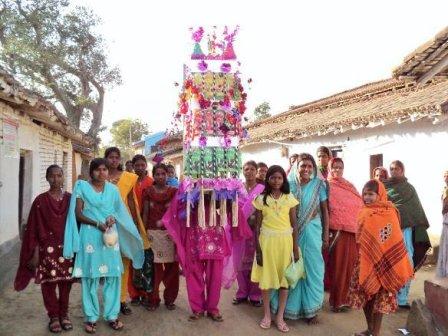Kaptipada: Odisha is home to diverse cultural traditions that have been passed through several generations. Like others ‘Tusu Parav’ and ‘Badam Parav’ are unique festivals which are celebrated by Kudumi community (a type of tribal community) as part of ‘Makara Parba’.
Kudumis are an important agricultural community of eastern India. They mainly reside in eastern part of Odisha i.e. in the two districts Mayurbhanj and Keonjhar. They celebrate different festivals and most of them are related to their agricultural activities. The Tusu Parav, Badam are the two most important festivals of Kudumis which are celebrated with equal joy and happiness.
Kudumis’ festivals season begins with Akhain Yatra which falls on the first day of Magha (January-February), then Badam Parab and continues till Tusu Parab. The celebration of Tusu festival takes place in mid-January during Makar Sankranti. It is celebrated mainly by female members and it can be termed as a women’s festival.
Badam Paraba is locally known as Bahundi. The previous day of Tusu Paraba is observed as Badama paraba. This is observed as the last day for farmers in an Odia year. Badam is the deity of this festival. In this festival, generally locals clean up their house and confess in front of Badam devata their ill deeds throughout the year. Old stocks at homes are destroyed at one place of a village after Dehuri (priest) performs the puja.
The night of the Badam is observed in three different ways. In the first phase of night, people bid farewell to the continuing year and give a warm welcome to the next year by offering fish bhog to the grama devati. In the second phase of the night, all villagers celebrate with the rhythm of dhol and music. And in the third phase of the night, all villagers wait for howls of jackals in the wee hour of Badam night.
After hearing the howls of jackals they start their farming activities for the next year.
It is believed that howls of jackels are a divine sign from god which will make the coming year of tribals happier with a good harvest.
Tusu is observed the next day of Badam puja that is on Makar Sankranti. The festival is a figurine of the goddess which is made by young tribal girls. People go in for a colourful procession around the village carrying ‘Tusu Devi’ on their shoulders. In the evening, they submerge the figurine in the river in a teary farewell to the goddess.
While it is unclear as to which goddess does the tribe actually worship, experts on the matter claimed that it’s the idol of Goddess Laxmi or Gayatri they pray in order to lead a good life. In fact, another name associated with Goddess Gayatri is ‘Supta Devi’ which has been gradually changed to ‘Tusu’.
The story behind Goddess Tusu is an interesting one. Once upon a time, a Kudumi King ruled over the areas of Chotnagpur’s Mala. He had a beautiful daughter named Tusu. However, a Muslim king who ruled over Odisha, wanted Tusu to satisfy his lust. Tusu came to know of this and decided to kill herself rather than lose her piousness.
However, many cultural experts of Kudumi community and of other communities have rubbished the fact that ‘Tusu’ is a mythological celebration. Famous sand artiste Dasarath Mohanta said, “It’s an honour to make her replica through sand art. I firmly believe that Tusu is a goddess who is worshipped by all Kudumi girls. Medini Murmu, a young girl of the community, said, “This day is marked by delicious food, cock fights and colourful attires.”
Her maids adorned her with fineries on the fateful day. In the evening, Tusu jumped from a bridge into the river. This day was celebrated as Makar Sankranti. Her sacrifice became a stuff of legend. Young Kudumi girls make figurines of Tusu and celebrate her character with a colourful procession amid dance and music.
PNN
